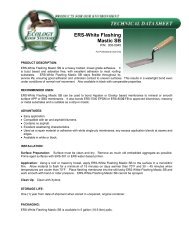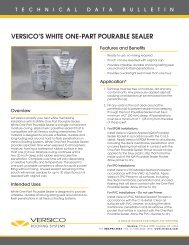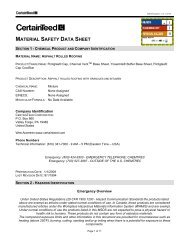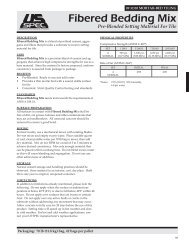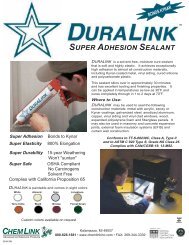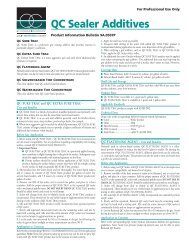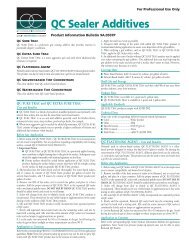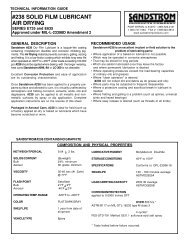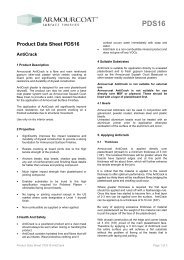Simpson Anchors - Anchoring and Fastening Systems - BuildSite.com
Simpson Anchors - Anchoring and Fastening Systems - BuildSite.com
Simpson Anchors - Anchoring and Fastening Systems - BuildSite.com
You also want an ePaper? Increase the reach of your titles
YUMPU automatically turns print PDFs into web optimized ePapers that Google loves.
C-SAS-2009 © 2009 SIMPSON STRONG-TIE COMPANY INC.<br />
CRACK-PAC ®<br />
Application<br />
Polyurethane injection is an effective <strong>and</strong> economical method of sealing<br />
cracks in concrete <strong>and</strong> solid masonry elements. Crack-Pac ® Flex-H 2 0 crack<br />
sealer is suitable for sealing dry, wet, seeping <strong>and</strong> mildly leaking cracks in<br />
horizontal <strong>and</strong> vertical concrete <strong>and</strong> solid masonry elements ranging from<br />
¹⁄₃₂" - ¹⁄₄".<br />
Defi nitions:<br />
Important: These instructions are intended as re<strong>com</strong>mended guidelines. Due to the variability of fi eld conditions,<br />
selection of the proper material for the intended application <strong>and</strong> installation are the sole responsibility of the applicator.<br />
Dry Crack–a crack containing no moisture<br />
Wet Crack–a crack containing moisture (damp or containing st<strong>and</strong>ing<br />
water). The surface can be dried <strong>and</strong> will remain dry during the<br />
paste-over operation.<br />
Seeping Crack–a wet crack that slowly oozes water. After being dried,<br />
the surface slowly be<strong>com</strong>es wet again.<br />
Mildly Leaking Crack–a crack with a slow trickle of water emitting<br />
from its face.<br />
NOTE: Multiple applications may be necessary to fi ll all voids.<br />
Dry or Wet Crack Application - Sealing of the crack <strong>and</strong> attachment<br />
of E-Z-Click fl ush mount injection ports (Model EIP-EZ or EIP-EZA)<br />
1. To adhere the port to the concrete,<br />
apply a small amount of epoxy around<br />
the bottom of the port base. Place the<br />
port at one end of the crack <strong>and</strong> repeat<br />
until the entire crack is ported. As a rule<br />
of thumb, injection ports should be placed<br />
8" apart along the length of the crack.<br />
Important: Do not allow epoxy to block<br />
the port or the crack under it, this is<br />
where adhesive must enter the crack.<br />
2. Using a putty knife or other paste-over<br />
tool, generously work epoxy along the<br />
entire length of the crack. Take care to<br />
mound the epoxy around the base of<br />
ports <strong>and</strong> to work out any holes in the<br />
material. It is re<strong>com</strong>mended that the<br />
paste-over should be a minimum of ¹⁄₈"<br />
thick <strong>and</strong> 1" wide. Insuffi cient paste-over<br />
will result in leaks under the pressure of<br />
injection. Allow the paste-over to cure<br />
before beginning injection.<br />
3. For Dry Cracks- Crack-Pac Flex-H20 reacts<br />
with water <strong>and</strong> needs moisture present<br />
to cure. Therefore, if the crack to be sealed<br />
is <strong>com</strong>pletely dry, water must be introduced<br />
into it. Once ports are in place <strong>and</strong> the crack<br />
surface is pasted over, use a syringe or<br />
spray bottle to introduce approximately<br />
1 ounce of water into each port.<br />
FLEX-H2O Injection Guide<br />
Note: CIP <strong>and</strong> CIP-F <strong>and</strong> ETR epoxies are a<br />
fast cure, manually mixed materials <strong>and</strong> may<br />
harden prematurely if left in a mixed mass on<br />
the mixing surface while installing ports.<br />
Spreading paste-over into a thin fi lm (approximately ¹⁄₈")<br />
on the mixing surface will slow curing by allowing<br />
the heat from the reaction to dissipate.<br />
1<br />
1.1<br />
2<br />
Preparation of the Crack for Injection<br />
Clean the crack <strong>and</strong> the surface surrounding it to allow the paste-up<br />
material to bond to sound concrete. At a minimum, the surface to receive<br />
paste-over should be brushed with a wire brush. Oil, grease or other surface<br />
contaminates must be removed in order to allow the paste-over to bond<br />
properly. Take care not to impact any debris into the crack during cleaning.<br />
With dry cracks, use clean, oil free <strong>com</strong>pressed air to blow out as much<br />
dust <strong>and</strong> debris from the crack.<br />
For many applications, additional preparation is necessary in order to seal<br />
the crack. Where a surfacing material has been removed using an acid or<br />
chemical solvent, prepare the crack as follows:<br />
1. Using clean, <strong>com</strong>pressed air, blow out any remaining debris <strong>and</strong> liquid.<br />
2. Remove residue by high-pressure washing or steam cleaning.<br />
3. Blow any remaining water from the crack with clean <strong>com</strong>pressed air.<br />
If a coating, sealant or paint has been applied to the concrete it must be<br />
removed before placing the paste-over material. Under the pressure of<br />
injection these materials may lift <strong>and</strong> cause a leak. If the surface coating is<br />
covering the crack, it may be necessary to route out the surface of the crack<br />
in a "V" shape using a grinder in order to get past the surface contamination.<br />
Seeping Crack Application - Sealing of the crack <strong>and</strong> attachment<br />
of E-Z-Click fl ush mount injection ports (Model EIP-EZ)<br />
1. Mix a small amount of quick-setting hydraulic cement with water in a<br />
container per manufacturer's re<strong>com</strong>mendation (leave cement thick so<br />
it can be molded). Apply the cement generously to the top of the port<br />
fl ange <strong>and</strong> hold the port onto the concrete/masonry surface at one end<br />
of the crack until it sticks when the h<strong>and</strong> is released (usually about<br />
1 minute). Repeat until the entire crack is sealed <strong>and</strong> ported.<br />
IMPORTANT: Be sure not to cover the port opening/closing interface<br />
with the cement. If this interface is covered, the cement must be<br />
cut away from this interface with a utility knife once it is cured,<br />
otherwise, the port will not close.<br />
2. To seal the remaining portions of the crack, mix small amounts of the<br />
hydraulic cement <strong>and</strong> apply it to the crack in a similar fashion. It is<br />
re<strong>com</strong>mended that the paste-over be ³⁄₁₆" thick <strong>and</strong> 1" wide. Once the<br />
entire crack is covered, all leaking water should be directed through the<br />
open ports. If water is leaking from any parts of the paste-over, be sure<br />
to patch these areas with additional hydraulic cement before injecting<br />
the crack.<br />
Mildly Leaking Crack Application - Sealing of the crack <strong>and</strong><br />
attachment of E-Z-Click drill-in injection ports (Model EIPX-EZ)<br />
1. Using a hammer drill or roto-hammer, drill ⁵⁄₈" holes ³⁄₄" deep at each<br />
end of the crack <strong>and</strong> along the crack approximately 8" apart.<br />
2. Using the E-Z-Click Drilled-In port (model EIPX-EZ), gently pound the<br />
port into the drilled hole at the top of a vertical crack or at either end<br />
of a horizontal crack. Mix a small amount of quick-setting hydraulic<br />
cement with water in a container per manufacturer's re<strong>com</strong>mendation<br />
(leave cement thick so it can be molded).<br />
3. Apply the cement generously to the top of the port fl ange <strong>and</strong> hold until<br />
it sticks when the h<strong>and</strong> is released (usually about 1 minute). Repeat<br />
until the entire crack is sealed <strong>and</strong> ported. IMPORTANT: Be sure not to<br />
cover the port opening/closing interface with the cement. If this<br />
interface is covered, the cement must be cut away from this interface<br />
with a utility knife once it is cured, otherwise, the port will not close.<br />
4. To seal the remaining portions of the crack, mix small amounts of the<br />
hydraulic cement <strong>and</strong> apply it to the crack in a similar fashion. Starting<br />
at one end <strong>and</strong> working toward the other. In vertical applications start at<br />
the top <strong>and</strong> work down. It is re<strong>com</strong>mended that the paste-over be at<br />
least ³⁄₁₆" thick <strong>and</strong> 1" wide. Once the entire crack is covered, all leaking<br />
water should be directed through the open ports. If water is leaking<br />
from any parts of the paste-over, be sure to patch these areas with<br />
additional hydraulic cement before injecting the crack.<br />
Crack Injection<br />
107



